What regular checks can be performed on the KAZ107-14.43-37KW-M3 gear reducer to prevent major overhauls?
To prevent major repairs to the KAZ107-14.43-37KW-M3 gearbox, the following inspections can be conducted regularly:
Lubrication system inspection
Oil level check: Observe the oil level through the oil gauge every week or before each start-up to ensure that the oil level is between the upper and lower limits. If it is insufficient, replenish it in a timely manner.

Oil condition detection: Monthly visual inspection and odor detection are used to determine whether the lubricating oil has deteriorated, such as blackening, odor, or the appearance of flocculent substances. Oil analysis should be conducted at least once a year to detect indicators such as viscosity, acid value, moisture, and impurity content. If they exceed the standard, they should be replaced immediately.
Cleaning and maintenance of lubrication system: Disassemble oil pipes and oil filters every 1-2 years, remove internal impurities and sludge, and ensure smooth flow of lubricating oil. At the same time, check the lubrication method. For splash lubrication, it is necessary to confirm that the oil level is appropriate and that the splash gear is operating normally; For forced lubrication, it is necessary to check whether the oil pump pressure and flow rate meet the standards, and whether the oil circuit is leaking or blocked.
Inspection of gears and mechanical components
Gear appearance and wear inspection: Stop the machine every quarter to check for defects such as wear, pitting, cracks, and broken teeth on the gear surface. Use a tooth thickness caliper or specialized instrument to measure the degree of tooth surface wear. When the wear exceeds 10% -15% of the design value, repair or replacement of the gear should be considered.
Mesh clearance and accuracy adjustment: Use a feeler gauge or dial gauge to check the gear mesh clearance every six months to ensure that the clearance is within the manufacturer's specified range. At the same time, check the coaxiality and parallelism of the gear shaft. If the error exceeds 0.05mm/m, it needs to be recalibrated and the connecting bolts between the gear and the shaft should be tightened to prevent loosening and displacement of the meshing position.
Bearing and housing maintenance: Every quarter, check whether the bearing is damaged by listening to sound and touching the temperature, and if necessary, use a vibration detector to detect the vibration value. Disassemble bearings every year, clean and inspect the balls and raceways for wear, and replenish or replace lubricating grease. Every month, check whether the anchor bolts of the box are loose, whether the foundation is flat, and whether there are cracks or deformations in the box. If necessary, repair or replace them in a timely manner.
Running status monitoring
Temperature and vibration monitoring: Install temperature sensors or use infrared thermometers to monitor the temperature of the gearbox in real time. During normal operation, the temperature rise should not exceed 40 ℃, and the maximum temperature should not exceed 80 ℃. Measure the vibration amplitude of each part of the gearbox with a vibration meter every month, record the data and compare it with historical values. If the vibration intensifies, it may indicate gear or bearing failure.
Load and speed control: Strictly operate according to the rated load of the reducer, and prohibit long-term overloading. For impact load equipment, install buffering devices to reduce the impact on gears during start-up/braking. Ensure that the input speed is stable within the design range to avoid an increase in gear centrifugal force and lubrication failure due to excessive speed.
Abnormal noise troubleshooting: Pay attention to whether the gearbox makes abnormal noises during daily operation. If any abnormalities are found, immediately stop the machine to check the gear meshing, bearing status, or lubrication to avoid the fault from expanding.

